Courtney Dauwalter: Step inside the 'pain cave', where rules are remade
- Published

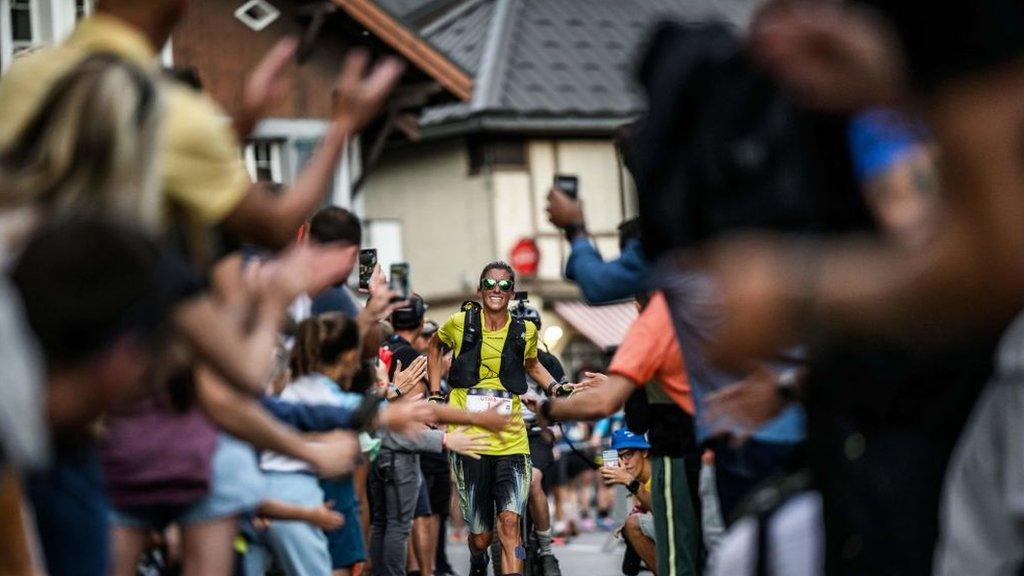
Dauwalter has won the women's race in three of the last four stagings of the Ultra-Trail du Mont-Blanc.
Sign up for notifications to the latest Insight features via the BBC Sport app and find the most recent in the series.
Chamonix is rocking. A voracious melee of thousands squeeze into the French town's narrow streets to witness the culmination of a true monster - the 106-mile (170km) race known as Ultra Trail du Mont Blanc.
Crossing three international borders while circling the tallest mountain in Europe, UTMB is widely regarded as one of the most competitive ultra-marathons on the planet. Combining a carnival atmosphere with a total elevation gain of 10,040 metres - more than 1,000 metres higher than Mount Everest - it is a bruising, bashing, blow-out of a weekend - and this one is particularly special.
Excitement pulses through the crowd. A distant roar splits the air. It creeps closer, gaining in volume. A glimpse of yellow appears. The crowd surge forward, almost engulfing the runner in her baggy shorts and slightly oversized T-shirt.
It is her third UTMB title. A remarkable summer of domination. An unprecedented triple crown of the sport's premier races. The queen of ultra-running has arrived.

Just over 10 years earlier, Courtney Dauwalter sat alone and dejected at an aid station after dropping out of her first 100-mile race, Run Rabbit Run,, external in Steamboat Springs, Colorado.
The remote location meant no easy escape - no simple way out. She would have to sit for hours watching others pass before the aid station closed and she could get a ride to the finishing area.
"When it started getting physically difficult, almost immediately my headspace went really negative, and I just whirlpooled down into it," says Dauwalter.
"Any runner will tell you that a 'did not finish' is a crushing experience. I couldn't believe I'd given up so quickly and quit something I'd started."
Alone and hurting, watching others gritting it out, she searched her mind for some resolve.
"I decided I was going to be a person who could finish 100 miles. I just had to make a new plan and figure out how. Later that day I signed up for a 100-mile race one year from then."
Since that demoralising day on a mountainside in 2012, Dauwalter has climbed to the summit of ultra-running.
Her triumph in Chamonix completed the triple crown of the Western States 100, Hardrock 100 and UTMB in a single summer - a feat never before achieved. She also holds the course record for each event.
But that was just this summer. Dauwalter has dominated women's ultra-running over the past 10 years. She hasn't been beaten by a female runner since 2019. In 2017, during the Moab 240, a savage 238-mile slog through the deserts of Utah, she obliterated the field - men and women - beating her nearest rival, Sean Nakamura, by 10 hours.
It sparked questions, debate and research into whether ultra-endurance distances might be among the only sporting arenas where the playing field between the sexes is effectively levelled.
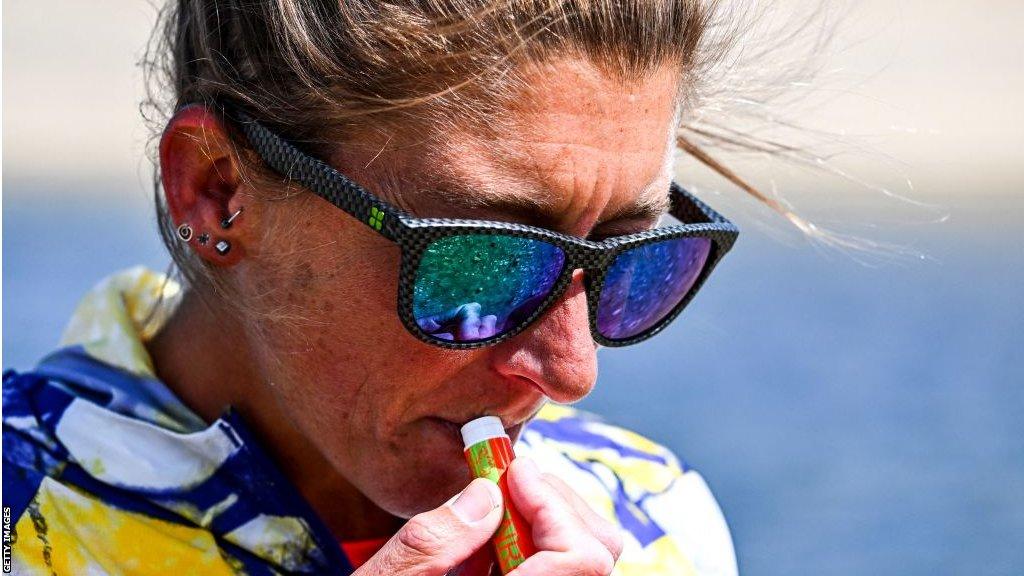
Dauwalter on a training run in Colorado in May
At the start of 2017, before everything changed, running was still a side project for Dauwalter, whose day job was teaching biology full-time in Colorado.
"I majored in biology in college and thought I would do something medical or in sports medicine, but I quickly figured out that that probably wouldn't be a good fit for me. So after college I decided that teaching would be a cool way to spread my love of science to others," says Dauwalter.
Throughout school and college, she ran regularly, often starting each day with a morning jog and entering the odd 5km or 10km - simply to have a healthy activity on a Saturday morning.
"I loved how it made me feel. I loved that I could push exactly as hard as I wanted during a race or training, and I loved that feeling of exploration and amazement at where my feet could take me," says Dauwalter.
She was a four-time Minnesota state champion in Nordic skiing and gained a cross-country skiing scholarship at the University of Denver, but there was little early indication of the extent of her running prowess.
"At the start line of my first marathon, I was texting goodbye to family and friends, saying my legs are going to shatter - I'm going to be a heap on the side of this road somewhere. But I finished it. I couldn't believe it," says Dauwalter.
"It triggered this whole domino effect. I thought running a marathon was impossible - but it wasn't. So I thought, what else is there that could be the same sort of challenge? And that led me to the ultra-running world."
Her first 50km went well, followed by a successful, albeit exhausting, 50-miler.
"So I decided the next logical step was to try the 100-mile distance."
The 2012 Run Rabbit Run ended badly. Each person who passed the aid station after Dauwalter had dropped out was a painful reminder of how she had failed at something she had set her mind to, but she now credits it as one of the most important moments in her running career.
"I was officially out of the race, but I had this front-row seat for evidence of what it takes. Look at all of these people who are clearly hurting, but they're finding a way. I kept asking myself, do you want to be a person who tries this again and figures it out?" says Dauwalter.
What came next was dramatic. For the next four years, she shared her time between teaching and ultra-running. Her results surged, and by 2014, she was dominating, winning seven major 50-mile, 100-mile, or 24-hour races that year.
In 2017, Courtney Dauwalter hit the mainstream. Having quit teaching to run full-time, she delivered two defining performances.
Dauwalter had already returned to win Run Rabbit Run the previous year, finally exorcising the ghost of 2012, but her victory in 2017 is the stuff of absurd legend.
Comfortably leading the race as she entered the last 12 miles, her vision began clouding from the periphery. Temporary distorted vision isn't unheard of in ultra-running; the stress of running so hard and long can mean the body struggles to refresh the fluid in the eyeball as usual. It is a condition known as corneal edema. But Dauwalter's case was particularly severe. As she continued towards the finish line, it worsened until she was effectively 90% blind.
"I was all alone on this trail in the Colorado mountains. I couldn't see my hand in front of my face, but I could still see my toes," says Dauwalter.
With only a few miles until the final aid station, Dauwalter stumbled along, occasionally falling - on one occasion drawing blood after hitting her head on a rock.
"Luckily, I knew that section of trail; I had run it many times before in training. A calm came over me - a computer mode asking what I could do. Well, I can look at my toes and keep moving forward as best as I can," says Dauwalter.
"This is my situation - here's the problem I've been dealt with. And then it was just figuring out my options and how to get out of this."
Dauwalter made it to the aid station, but instead of dropping out, she used a volunteer to guide her by narrating the terrain as they ran. A battered and bleeding Dauwalter crossed the finish line - the first woman to do so that day - in 20 hours 38 minutes 09 seconds,, external with her vision returning to normal five hours later.
That experience would have traumatised many, but just three weeks later, she entered and won the 50-mile Bear Chase in Colorado, beating the nearest man into second place by nearly two hours.
Dauwalter runs with a wide grin and often takes time to chat with volunteers and people along the trail, but competing, never mind winning, over these distances requires something primal. An ability to tame the beast that screams it's impossible. To keep going when your eyes are failing - when your body is capitulating. Beneath the cheery exterior lies a relentless survivor.
"The number of problems and types of problems you can get in ultra-running are abundant. My process is just to start repeating a positive mantra to myself in my head," says Dauwalter.
"I think it helps me to just calm down all of my systems. If I have this very simple positive phrase - You're fine. This is fine. Everything is fine. Keep moving - repeating in my brain, the rest of me can start thinking through what's going on and what I can do about it.
"Do I have any experience of this sort of thing in the past? What have I tried before? What could I try this time?"
When things really get tough, she uses a mental exercise she calls her 'pain cave'.
"The pain cave is where I go when it physically feels like I can't take another step. It's a visual I have of this space in my brain that I go to with a chisel, and I just go to work on making it bigger, which helps to stay mentally tough in those difficult moments - and makes my capacity for suffering bigger," says Dauwalter.
"Your brain is so powerful. Figuring out how to use both my body and my brain keeps me signing up for these really tough challenges because I want to keep testing myself."
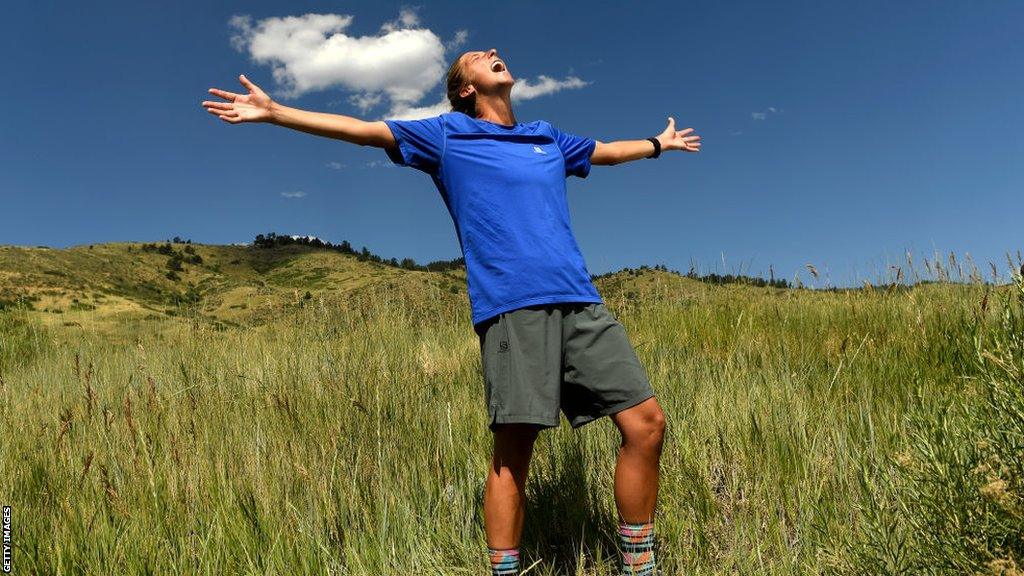
Dauwalter's trademark baggy shorts and laid-back approach to nutrition have endeared her to fans
Five weeks after her arduous 2017 Run Rabbit Run victory, Dauwalter entered the Moab 240 - by far the furthest she had ever run. She kept her race ambitions beforehand in check, but 57 hours after starting, Dauwalter crossed the finish line in first place overall. Second-placed Nakamura didn't appear for more than 10 hours.
Women had beaten men in ultra-endurance events before Dauwalter came along, and it has happened many times since, but her achievements in the Moab 240 sparked a flurry of further research and media attention. Perhaps more importantly, it showed what is possible.
In 2019, Jasmine Paris won the UK's 238-mile Spine Race outright, while Maggie Guterl became the first woman to win the Big Dog's Backyard Ultra - a 4.16667-mile loop that must be completed once every hour until there is only one person left - running 250 miles in 60 hours, with two other women in the top 10 that year.
Camille Herron has been dominating for years and remains the only athlete to win the 50K, 100K, and 24 Hours at ultrarunning's road World Championships, as well as the first to win both the Comrades and Spartathlon ultra marathons.
Research suggests that, the greater the distance in a race - running, cycling or especially swimming - the smaller the gap between men and women. Until there comes a point where women take the lead.
In professional marathons, women are, on average, 11.1% slower than men. Greater muscle mass and a higher V02 range mean that, barring a long shot, women will always finish behind men over this distance when ability levels are considered. Yet at 50 miles, there is only a 3.7% difference; at 100 miles, just 0.3% separates men and women.
"It seems 195 miles is the magic number where women become faster than men," says Jovana Subic, head of running research at Run Repeat, a website that analysis running shoes and the sport in general and which released a State of Ultra Running Report in 2020. , external
Statistics above this distance show that women are, on average, 0.6% faster.
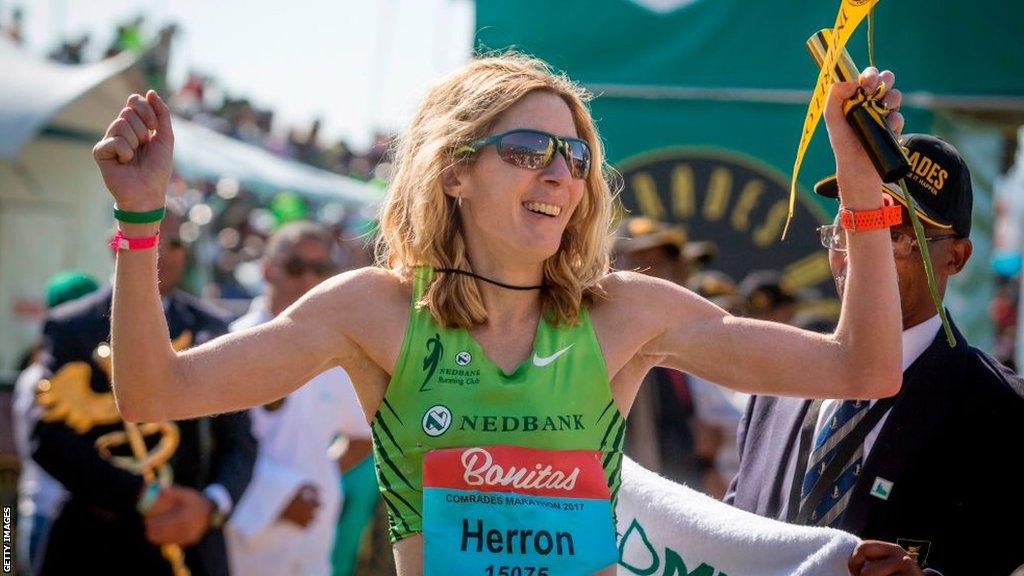
Camille Herron, who finished third overall in the 153-mile Spartathlon race in October, is another woman whose achievements are challenging convention
More research is needed, but there are suggestions the point where women overtake comes when their greater distribution of slow-twitch muscle fibres - providing more resistance to fatigue - becomes an advantage. Ultra-endurance athletes also aren't often required to reach their maximum output capacity - where men shine. Instead, it's about peripheral conditioning, oxygen efficiency, and mental toughness.
Other possible causes could be that women tend to burn fat more efficiently than men and generally keep a steadier pace during long races.
"Women burn out less and are 18% better at keeping an even pace," says Jovic.
As Dr Nicholas Tiller, an exercise scientist at Harbor-UCLA Medical Center, says: "Endurance distances are the great equaliser."
However, one point that Dr Tiller is often keen to stress is the importance of approaching the subject with objectivity. Dauwalter may have trounced the men in 2017, but that doesn't mean she does it every race. At the UTMB in 2023, fellow American Jim Walmsley finished nearly four hours ahead of her.
Another point to bear in mind is that these findings are based on niche events in which female participation shrinks the further the distance, meaning there is limited data. And with conclusions based on averages, numbers can easily become skewed. A few elite female runners pitted against a larger number of men of more varied ability makes sweeping generalisations difficult. We will have a clearer idea of any gender-linked advantages when participation levels match up.
Women have several disadvantages, such as a lower O2-carrying capacity, prevalence of gastrointestinal distress, and sex-hormone effects on both cellular function and injury risk - according to Tiller's report , external'Do Sex Differences in Physiology Confer a Female Advantage in Ultra‑Endurance Sport?'
Herron, Paris, Guterl and Dauwalter don't win simply because they are women. They are women who win because of extraordinary dedication, hard work and ferocious resilience. They have advantages but also disadvantages compared to their male counterparts, and trying to simplify the argument can be reductive.
There are no definitive conclusions. But there is an argument that the greater the distance, the closer you come to a truly level playing field in sport.
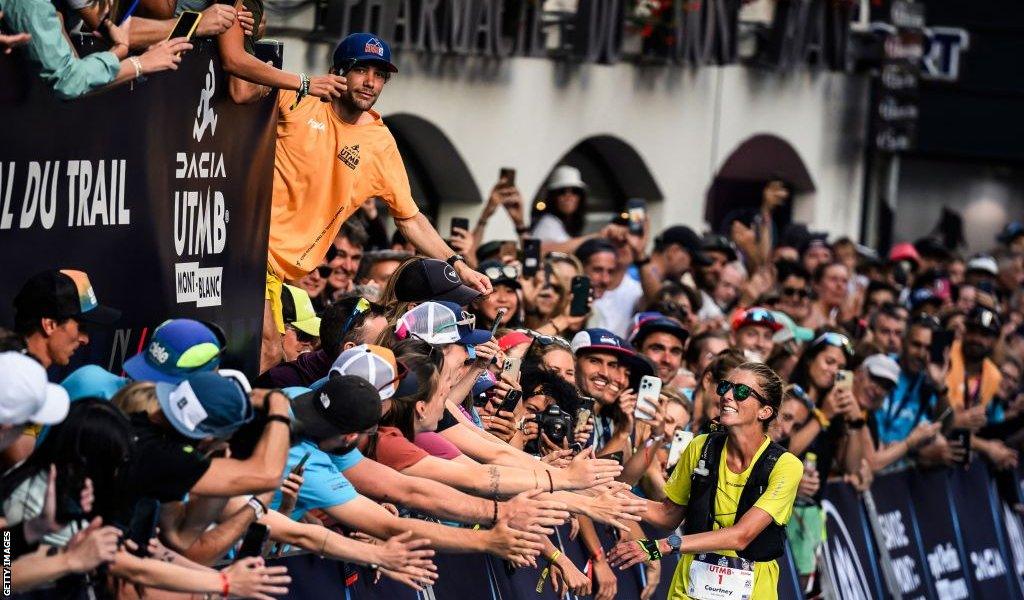
Dauwalter, who finished more than 40 minutes clear of the next woman and 25th in an overall field of 2693 runners, greets fans close to the UTMB finishline
Pushing one's body over such distances is beyond most mortals - or at least we think it is. However, numbers, particularly on the female side, are rising rapidly.
"More people are thinking, why not try - why not do something hard and just see what happens? It's a cool time to be a woman in ultra running because it's growing so much right now," says Dauwalter.
At the first UTMB in 2003, only seven women finished the race, but 20 years later, 188 crossed the finish line in Chamonix. Times also are plummeting. In 2003, Kristin Moehl ran 153km in 29:38:24, while in 2021, Dauwalter ran a course 18km further and did it seven hours faster.
On 1 September 2023, Dauwalter made her way through the delirious crowds in the French town, crossing the line in a time of 23:29:14. Her race number that day, appropriately, was one. It capped a remarkable summer where she reigned supreme - winning three of the most challenging 100-mile ultras around in the space of just 70 days.
The Queen of ultra-running is now 38, but if anything, she's gaining momentum.
And Dauwalter still approaches her sport with a carefree attitude. She drinks beer and eats pizza, loves sweets and cheese quesadillas. She usually averages around 100 miles per week but doesn't follow a regimented training routine.
"I'll just head out in the morning and run however far I feel," says Dauwalter. In a world of disciplined, straight-faced sports in which athletes ditch the joy in pursuit of marginal gains, Dauwalter often has the air of an adult who never grew out of her skateboarder phase.
"I want to eat and drink what sounds good. I want to hang with family and friends, and I want to sign up for these 100 or 200-mile races and push myself as hard as I can," she says
With her success, who's to say it's not the right approach? Dauwalter is dominating her sport in an unprecedented manner but refuses to trade a full, rich and rounded life for guaranteed competition success.
"My husband and I are trying to live this life as fully as we can. My hope is that I'm collecting all sorts of memories and moments that when I'm old and sitting on my rocking chair with my husband reflecting on life, we are laughing and smiling fondly about," says Dauwalter.
"This is our one go at life. So let's squeeze everything we can out of every single aspect of it."

Dauwalter lives in Leadville, Colorado, at an altitude of more than 3,000m